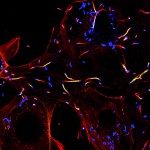Lien vers Pubmed [PMID] – 16039578
Immunity 2005 Jul;23(1):41-51
Mouse IgG subclasses display a hierarchy of in vivo activities, with IgG2a and IgG2b showing the greatest protective and pathogenic properties. These enhanced activities result, in part, from their ability to bind to a novel, gamma chain-dependent, activating IgG Fc receptor, FcgammaRIV. FcgammaRIV maps in the 75 kb genomic interval between FcgammaRII and FcgammaRIII; its expression is restricted to myeloid lineage cells, and it binds to IgG2a and IgG2b with intermediate affinity. No binding to IgG1 or IgG3 was observed. Blocking FcgammaRIV binding to pathogenic anti-platelet antibodies is sufficient to protect mice from antibody-induced thrombocytopenia. Thus, the FcgammaR system has evolved distinct activation receptors displaying selectivity for IgG subclasses, with IgG1 antibodies exclusively dependent on FcgammaRIII, whereas IgG2a and IgG2b show preferential dependence on FcgammaRIV activation. These distinct binding affinities for the IgG subclasses to FcgammaRs account for their differential protective and pathogenic activities in vivo.
